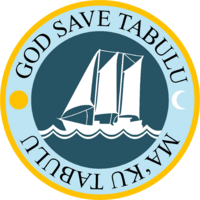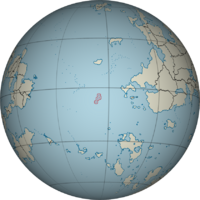Tabuluan Language: Difference between revisions
No edit summary |
No edit summary |
||
| (2 intermediate revisions by the same user not shown) | |||
| Line 4: | Line 4: | ||
| nativename = Ko'Tabulu | | nativename = Ko'Tabulu | ||
| image = [[File:Tabulu_Islands_Seal.png|200px]] | | image = [[File:Tabulu_Islands_Seal.png|200px]] | ||
| imagecaption = ''National Seal of [[Tabulu]], depicting the phrase "God Save Tabulu" in both | | imagecaption = ''National Seal of [[Tabulu]], depicting the phrase "God Save Tabulu" in both Common and Tabuluan.'' | ||
| pronunciation = /kaːtæbuːluː/ | | pronunciation = /kaːtæbuːluː/ | ||
| state = [[Tabulu]] | | state = [[Tabulu]] | ||
| Line 11: | Line 11: | ||
| speakers = 149,000 | | speakers = 149,000 | ||
| date = 2014 | | date = 2014 | ||
| speakers2 = 56,300 | | speakers2 = {{wp|L2 Speakers}}: 56,300 | ||
| familycolor = Austronesian | | familycolor = Austronesian | ||
| fam1 = [[Thuadia|Thuado-]][[Caleren | | fam1 = [[Thuadia|Thuado-]][[Caleren]] | ||
| fam2 = [[North | | fam2 = [[North Caleren Language|North Caleren]] | ||
| fam3 = [[Kristalotovode Language|Kristalotovode]] | | fam3 = [[Kristalotovode Language|Kristalotovode]] | ||
| fam4 = [[Tabouhuianian Language|Tabouhuianian]] | | fam4 = [[Tabouhuianian Language|Tabouhuianian]] | ||
| ancestor = [[Old Tabuluan Language]] | | ancestor = [[Old Tabuluan Language|Old Tabuluan]] | ||
| ancestor2 = | | ancestor2 = | ||
| dia1 = [[High Tabuluan]] | | dia1 = [[High Tabuluan]] | ||
| dia2 = [[Low Tabuluan]] | | dia2 = [[Low Tabuluan]] | ||
| dia3 = [[Torvonese-Tabuluan Creole]] | | dia3 = [[Torvonese-Tabuluan Creole]] | ||
| dia4 = [[Common-Tabuluan Creole]] | | dia4 = [[Common-Tabuluan Creole]] | ||
| script = [https://wikipedia.org/wiki/Latin_Alphabet Common Alphabet] | | script = [https://wikipedia.org/wiki/Latin_Alphabet Common Alphabet]<br>[[Tabuluan Alphabet]] | ||
| sign = | | sign = | ||
| posteriori = | | posteriori = | ||
| Line 50: | Line 50: | ||
| notice = IPA | | notice = IPA | ||
}} | }} | ||
Tabuluan, known as Ko'Tabulu | Tabuluan, known by its native speakers as Ko'Tabulu, and by [[Torvon|Torvonese]] Tabuluans as Tabjulina, is the national language of [[Tabulu]]. Its origin can be traced back to early [[Caleren]] languages, although the only common similarities between modern Caleren languages and Tabuluan languages are the [https://en.wikipedia.org/wiki/Phonetics phonetic sounds], as well as [https://en.wikipedia.org/wiki/Latin_alphabet the alphabet] in some former colonies. Overall, Tabuluan is considered a highly difficult language to learn with no practical usage, and therefore is scarcely spoken by non-Tabuluans. Tabuluan has four distinct dialects, [[High Tabuluan]] being the most commonly spoken. The other three dialects ([[Low Tabuluan]], [[Torvonese-Tabuluan Creole]], and [[Common-Tabuluan Creole]]) are spoken by roughly 28% of Tabuluan speakers, while High Tabuluan makes up 72 percent. | ||
Tabuluan's earliest origins can be traced back to the Thuado-Calerens, in modern-day [[Kilowatt]] and [[Ganji Islands]] respectively. Around 2,200 years ago, a small collection of peoples from both these territories began a migration, meeting at Tabulu. The languages and grammar syntaxes began to blend, resulting in modern Tabuluan grammar, of which has remained largely unchanged throughout the ages. Some common sounds were also inherited from the Calerens, and the Tabuluan alphabet can find its origins in older Caleren alphabets. [[Old Tabuluan]], the predecessor to Tabuluan, was less reliant on verbal communication and partially used dexterous communication in a form of early [https://wikipedia.org/wiki/Sign_Language sign language]. | |||
High Tabuluan, also sometimes called Common Tabuluan, is the most commonly spoken dialect. High Tabuluan has very few differences between Low Tabuluan, the primary difference being that High Tabuluan uses the Common alphabet as opposed to the Native [[Tabuluan alphabet]]. Low Tabuluan is spoken by only 4,200 people as a native language, Still, verbal communication can occur between the two dialects, as they are the same language with minute differences. The [https://wikipedia.org/wiki/Creole_Languages Creole] dialects, however, are much harder for High and Low Tabuluan speakers to understand, although if one knows either [https://wikipedia.org/wiki/English Common] or [https://wikipedia.org/wiki/Slovenian_Language Torvonese], the dialects are understandable with relative ease. Both dialects of Creole use the Common alphabet, and are often learned prior to taking the step towards High or Low Tabuluan. | |||
Tabuluan is | Tabuluan is regulated by the Tabuluan States' [[Ministry for Culture and Linguistics]]. | ||
=Categorization= | |||
The most broad categorization of Tabuluan language is the [[Thuadia|Thuado-]][[Caleren]] family under the [[North Caleren Language|North Caleren]] subgroup. Of the North Caleren subgroup, the [[Kristalotodove]] linguistic family encompasses Tabulu as well as the majority of other islands within the geographic region. Tabuluan is relatively similar to other Kristalotodovite languages, and overall it is considered easier for speakers of a Kristalotodovite language to understand and learn Tabuluan. Below the Kristalotodove group is the [[Tabouhuianian Language|Tabouhuianian family]], of which Tabuluan is the only language that still exists. Old Tabuluan was of the Tabouhuianian family, and modern Tabuluan is a direct descendant. | |||
{{Pie chart | |||
| radius = 100 | |||
| thumb = left | |||
| caption = Distribution of dialects of Tabuluan. | |||
| other = | |||
| label1 =High Tabuluan | |||
| value1 =72.1 | |||
| color1 =#800000 | |||
| label2 =Torvonese-Tabuluan Creole | |||
| value2 =12.9 | |||
| color2 =#008080 | |||
| label3 =Common-Tabuluan Creole | |||
| value3 =11 | |||
| color3 =#8fbc8f | |||
| label4 =Low Tabuluan | |||
| value4 =4 | |||
| color4 =#daa520 | |||
}} | |||
Predictably, the isolation from other Caleren civilizations caused Tabuluan to diverge and form considerably differently. While the Tabuluan dialects are [https://wikipedia.org/wiki/Mutual_Intelligibility mutually intelligible], no form of Tabuluan, Creole or otherwise, is mutually intelligible with any other language. Still yet, some languages that died out 1,800-2,000 years ago do share a resemblance with Old Tabuluan, especially in grammar syntax. | |||
Latest revision as of 18:10, 24 March 2021
| Tabuluan | |
|---|---|
| Tabulian | |
| Ko'Tabulu | |
 National Seal of Tabulu, depicting the phrase "God Save Tabulu" in both Common and Tabuluan. | |
| Pronunciation | /kaːtæbuːluː/ |
| Native to | Tabulu |
| Region | Kristalotovode |
| Ethnicity | Tabuluan |
Native speakers | 149,000 (2014) L2 Speakers: 56,300 |
Early form | |
| Dialects | |
| Common Alphabet Tabuluan Alphabet | |
| Official status | |
Official language in | |
Recognised minority language in | |
| Language codes | |
| ISO 639-1 | tb |
| ISO 639-2 | tbu |
| ISO 639-3 | tbn – inclusive codeIndividual codes: htu – High Tabuluanltu – Low Tabuluanttc – Torvonese-Tabuluan Creolectc – Common-Tabuluan Creole |
| Glottolog | tabu1099[1] |
 Map displaying Tabulu in red, indicating the only areas where Tabuluan is spoken by more than 5% of the population. | |
Tabuluan, known by its native speakers as Ko'Tabulu, and by Torvonese Tabuluans as Tabjulina, is the national language of Tabulu. Its origin can be traced back to early Caleren languages, although the only common similarities between modern Caleren languages and Tabuluan languages are the phonetic sounds, as well as the alphabet in some former colonies. Overall, Tabuluan is considered a highly difficult language to learn with no practical usage, and therefore is scarcely spoken by non-Tabuluans. Tabuluan has four distinct dialects, High Tabuluan being the most commonly spoken. The other three dialects (Low Tabuluan, Torvonese-Tabuluan Creole, and Common-Tabuluan Creole) are spoken by roughly 28% of Tabuluan speakers, while High Tabuluan makes up 72 percent.
Tabuluan's earliest origins can be traced back to the Thuado-Calerens, in modern-day Kilowatt and Ganji Islands respectively. Around 2,200 years ago, a small collection of peoples from both these territories began a migration, meeting at Tabulu. The languages and grammar syntaxes began to blend, resulting in modern Tabuluan grammar, of which has remained largely unchanged throughout the ages. Some common sounds were also inherited from the Calerens, and the Tabuluan alphabet can find its origins in older Caleren alphabets. Old Tabuluan, the predecessor to Tabuluan, was less reliant on verbal communication and partially used dexterous communication in a form of early sign language.
High Tabuluan, also sometimes called Common Tabuluan, is the most commonly spoken dialect. High Tabuluan has very few differences between Low Tabuluan, the primary difference being that High Tabuluan uses the Common alphabet as opposed to the Native Tabuluan alphabet. Low Tabuluan is spoken by only 4,200 people as a native language, Still, verbal communication can occur between the two dialects, as they are the same language with minute differences. The Creole dialects, however, are much harder for High and Low Tabuluan speakers to understand, although if one knows either Common or Torvonese, the dialects are understandable with relative ease. Both dialects of Creole use the Common alphabet, and are often learned prior to taking the step towards High or Low Tabuluan.
Tabuluan is regulated by the Tabuluan States' Ministry for Culture and Linguistics.
Categorization
The most broad categorization of Tabuluan language is the Thuado-Caleren family under the North Caleren subgroup. Of the North Caleren subgroup, the Kristalotodove linguistic family encompasses Tabulu as well as the majority of other islands within the geographic region. Tabuluan is relatively similar to other Kristalotodovite languages, and overall it is considered easier for speakers of a Kristalotodovite language to understand and learn Tabuluan. Below the Kristalotodove group is the Tabouhuianian family, of which Tabuluan is the only language that still exists. Old Tabuluan was of the Tabouhuianian family, and modern Tabuluan is a direct descendant.
Distribution of dialects of Tabuluan.
Predictably, the isolation from other Caleren civilizations caused Tabuluan to diverge and form considerably differently. While the Tabuluan dialects are mutually intelligible, no form of Tabuluan, Creole or otherwise, is mutually intelligible with any other language. Still yet, some languages that died out 1,800-2,000 years ago do share a resemblance with Old Tabuluan, especially in grammar syntax.
- ↑ Hammarström, Harald; Forkel, Robert; Haspelmath, Martin, eds. (2017). "Tabuluan". Glottolog 3.0. Jena, Germany: Max Planck Institute for the Science of Human History.